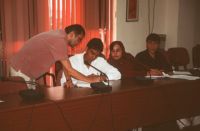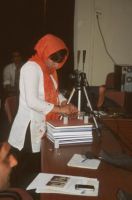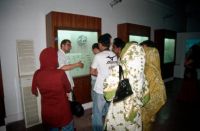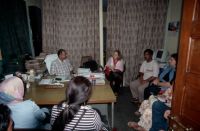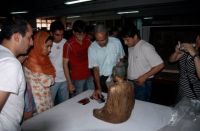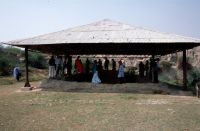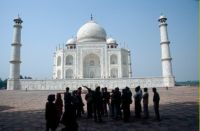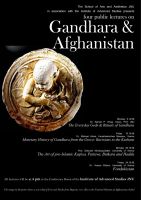Dear visitors,
please note that you are currently viewing the CIRDIS' old website. Its content is no longer being updated but it will remain online as a documentation of our previous work under this address: http://www.univie.ac.at/cirdis/2006-2015
Our new online presence can be found at the usual: http://www.univie.ac.at/cirdis
Training Course at the JNU in Delhi October 2008
(Central Asia and Gandhara, Numismatics, Early Buddhist Iconography, Art and Archaeology)
The training course for 8 members from the National Museum of Afghanistan in Kabul was held at the Jawaharlal Nehru University (Delhi) under the joint sponsorship of the Gerda Henkel Fund in Germany and the University of Vienna (the Center for Interdisciplinary Research and Documentation of Inner and South Asian Cultural History (CIRDIS)), the Austrian Science Fund (FWF), as well as the Kunsthistorisches Museum (Vienna), the Austrian Academy of Sciences in collaboration with the Jawaharlal Nehru University (Institute of Advanced Studies (JNIAS) and the School of Arts and Aesthetics) Delhi.
The accommodations for all participants of the training program for the members of the Kabul Museum, as well as for the scholars from Vienna, were provided by the JNIAS. Also all training sessions (including some lectures) were held in the seminar room of the JNIAS. All rooms were provided with internet, which was a great facilitation of the training program. We are especially grateful for the hospitality and the support of JNIAS and Prof. Aditya Mukherjee.
Numismatic seminar
Delhi, 06. 10. – 17. 10. 2008
Univ.‐Doz. Dr. Michael Alram, Director of Coin Cabinet, Kunsthistorisches Museum, Vienna
Dr. Nikolaus Schindel, Member of Numismatic Commission, Austrian Academy of Sciences
Dr. Klaus Vondrovec, Coin Cabinet, Kunsthistorisches Museum, Vienna
The Numismatic training was held by three Austrian scholars for two weeks: The curriculum covered the technical basics of coin‐striking, numismatic vocabulary, and the principles of scientific methodology. In addition a complete overview of the pre‐Islamic monetary history of Central Asia was given.
Six lectures were also held jointly for students in Art History class at the JNU, one lecture was given for a public audience. Training sessions were held every morning and afternoon for the staff of the Kabul Museum only. Despite the lack of original coins (for study‐purposes) the technical equipment of the JNU greatly facilitated teaching and also allowed us to apply databases and digital photography right at the spot.
Despite occasional difficulties with the English language all curators of the Kabul Museum are to be complimented for their diligence. The curators worked intensely 6 days a week and learned a great deal. It seems very desirable to proceed with teaching this fundamental course. More specialized training will be given especially for the curators responsible for coins of the Greco‐Bactrian and Kushan‐periods. We continue to sponsor intensive English courses in the Kabul Museum.
Art History Seminar
Delhi, 20. 10. – 31. 10. 2008
Univ. Prof. Dr. Deborah Klimburg‐Salter, Prof. for Asian Art History, Department of Art History,
University of Vienna
Dr. Verena Widorn, CIRDIS, Department of Art History, University of Vienna
DI Uwe Niebuhr, CIRDIS, Department of Art History, University of Vienna
The Art History training program was conducted by three Austrian scholars from the Department of Art History, University Vienna. The training was focused on the basics of Buddhist iconography and the early period of Buddhist Art in South and Central Asia. An introduction to the development of the Buddha image covered the art of Sanchi, Bharhut and Gandhara. Special attention was given to the study of technical terms, hand gestures, positions and attributes. The training program was complemented by visits to the National Museum in Delhi, the Mathura Museum and the Tibet House collection, where it was possible to study original objects. Excursions to the excavation areas of Mat and Sonkh enabled the members of the Kabul Museum and JNU students to better understand Buddhist sites from the 2nd century. In addition to daily tutorials for the Kabul Museum curator only, five lectures were also held jointly for JNU students, three of them for a public audience (see program).
Despite their different areas of specialization in the Kabul Museum, all curators have actively participated in all the training sessions and profited from this scientific exchange. A continuation of the program is certainly recommendable.
Database Training
Delhi, 20. 10. – 31. 10. 2008
DI Sean Mc Allister, CIRDIS, Department of Art History, University of Vienna
The established requirements established by the Kabul Museum are the digitization of photos and inventory sheets. The Museum is currently using a database program developed by the computer science department of the University of Cologne during a workshop with Zia Afshar. In cooperation with the Curators, Sean Mc Allister developed a database structure, which represented all aspects of the inventory sheets. Based on this development process he tried to explain the basic principles of database design and programming with the goal of giving them a system which they can not only use but also modify to their needs. The project can be considered far from over because the IT infrastructure is not in place at the Kabul Museum.
Complementary Program
Group visits to the monuments of Mehrauli Archaeological Park (04.10.); Lotus Temple, Dilli Hat Market, Safdarjung Tomb, Hauz Khaz Village (05.10.); Ramayana performance (09.10.); numismatic collections at National Museum of New Delhi (10.10.); Red Fort, Old Delhi Market, Jami Masjid mosque (11.10.); Nizamuddin Tomb and complex (16.10.); excavation site of Sonkh and Mat, Mathura Museum (17.10.); to Agra: Taj Mahal, Itimad-ud‐Daulahs Tomb, Sikandra (18.10.); Gandhara and Central Asia collections in National Museum of New Delhi (22.10.); Humayuns Tomb, Nehru Memorial Museum and Library (25.10.); Old Delhi Market, Jami Masjid mosque, India Gate (28.10.); Tibet House Museum and Library (29.10.); Akshardham Temple (Akvita Singh) (31.10.).
Lectures
Monday, 06. 10. 08 ‐ Dr. Naman P. Ahuja, Assoc. Prof. JNU -
The Everyday Gods & Rituals of Gandhara
Friday, 10. 10. 08 ‐ Dr. Michael Alram, Kunsthistoriches Museum, Vienna ‐ Monetary History of Gandhara from the Greco‐ Bactrians to the Kushans
Monday, 20. 10. 08 ‐ Prof. Deborah Klimburg‐Salter, University of Vienna ‐ The Art of pre‐Islamic Kapisa, Paitava, Butkara and Hadda
Friday, 24. 10. 08 ‐ Dr. Verena Widorn, University of Vienna – Fondukistan
Download Report + Timtable in PDF-Format
Download File: Delhi 2008 Report for JNIAS.pdf




